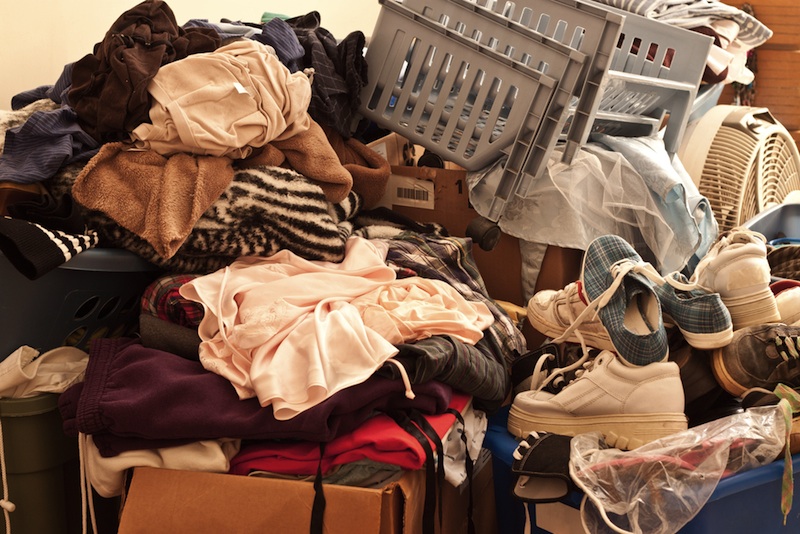Inside a Hoarder's Brain: Why They Can't Ditch Their Stuff

Hoarders, or people who can't bear to throw away even the most useless of junk, often can't see that they have a problem. But now new research pinpoints that problem in the brains of these individuals.
A new study finds abnormal activity in brain regions of people with hoarding disorder who were asked to make decisions about keeping something versus tossing it. The brain regions involved are known to be involved with decision-making under uncertain conditions as well as risk assessment and emotional choices.
"Hoarding seems to be characterized by problems in the decision-making process that can be seen in patterns of brain activity," said David Tolin, the director of the anxiety disorders center at the Connecticut-based mental health center The Institute of Living.
The cluttered brain
People with hoarding disorder have been made famous by the A&E documentary series "Hoarders," which follows individuals as they struggle with debilitating amounts of clutter in their homes. People with hoarding disorder acquire lots of stuff and are psychologically unable to throw it away.
The drive to hoard has been linked with a number of other psychological impairments, from difficulty with attention to problems making decisions. As odd as it may seem given that many hoarders' homes are piled with junk and garbage, the disorder is associated with perfectionism, tied to a fear of making the wrong decision. [Top 10 Controversial Psychiatric Disorders]
Psychologists originally thought of hoarding as an offshoot of obsessive compulsive disorder, but more research and treatment experience have shown that the two disorders don't overlap nearly as often as assumed, Tolin told LiveScience. To find out what really goes on in a hoarder's brain, he and his colleagues used functional magnetic resonance imaging (fMRI) to examine the activity in the brain as 43 people with hoarding disorder were asked to make decisions about keeping items or throwing them away. The fMRI measures changes in blood flow to brain regions in real time, allowing scientists to determine which regions are more active during any given task.
Get the world’s most fascinating discoveries delivered straight to your inbox.
For comparison, the researchers also scanned the brains of 33 healthy adults and 31 adults with obsessive compulsive disorder.
Keep or toss?
In each case, participants were asked to bring a pile of junk mail and newspapers from home without sorting through it. The researchers then showed the participants pictures of this junk paper while they were in the brain scanner, interspersed with photos of similar junk mail belonging to the research lab. Before each photo, the participants were shown a label stating whether the junk mail was theirs or the lab's. The participants were then asked whether the researchers should keep the mail and give it to the participant or whether they should shred it.
Unsurprisingly given their diagnosis, the hoarding disorder group discarded fewer pieces of junk paper and reported more anxiety, indecisiveness and sadness while making their choices than the other groups. Their brains told a more interesting tale: When asked to make a choice about their own mail, the hoarding participants saw a spike in activity in the anterior cingulate cortex and the left insular cortex.
The insular cortex is a section of brain that sits along each side of the head, folded deep within one of the organ's surface wrinkles. The anterior cingulate cortex is deep in the front of the brain.
Making decisions about their own junk sent these areas into overdrive in hoarder's brains. But when the hoarders made decisions about someone else's stuff, the same brain regions were unusually quiet.
Similarly, the insular cortex on the right side of the brain became more active when hoarders looked at their own mail than it did when they saw the lab's junk paper. Depression and OCD did not explain these brain differences.
Together, the insula and anterior cingulate cortex form a network that helps people decide how relevant and important things are, Tolin said.
"For us to make a good decision, you need a certain amount of activity in that network," he said. "Too little and you're not paying attention, you're under-stimulated. Too much and you're overwhelmed."
That's what seems to happen to hoarders, Tolin said. They're under-stimulated when confronting the vast amounts of junk and clutter that fill their homes. But when faced with a decision that matters to them, these brain regions go into overdrive, overwhelming them to the point where they can't make a choice at all.
"They avoid it because it's too painful," Tolin said. "And the clutter continues to build."
Tolin and his colleagues detail their findings today (Aug. 6) in the journal Archives of General Psychiatry.
Follow Stephanie Pappas on Twitter @sipappas or LiveScience @livescience. We're also on Facebook & Google+.

Stephanie Pappas is a contributing writer for Live Science, covering topics ranging from geoscience to archaeology to the human brain and behavior. She was previously a senior writer for Live Science but is now a freelancer based in Denver, Colorado, and regularly contributes to Scientific American and The Monitor, the monthly magazine of the American Psychological Association. Stephanie received a bachelor's degree in psychology from the University of South Carolina and a graduate certificate in science communication from the University of California, Santa Cruz.


